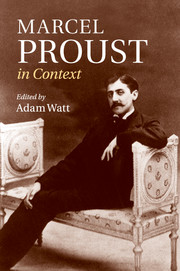Book contents
- Frontmatter
- Contents
- List of Illustrations
- Notes on contributors
- Figure I. Marcel Proust, portrait in oils by Jacques-Émile Blanche, 1892
- Preface
- Figure 2. Proust photographed on his death-bed by Man Ray, 1922
- Note on the text
- Chronology
- Part I Life and works
- Part II Historical and cultural contexts
- i. The arts
- Chapter 6 Proust's reading
- Chapter 7 Decadence and the fin de siècle
- Chapter 8 Paris and the avant-garde
- Chapter 9 The novelistic tradition
- Chapter 10 Philosophy
- Chapter 11 Painting
- Chapter 12 Music
- Chapter 13 Theatre and dance
- ii. Self and society
- Part III Critical reception
- Further reading
- Index
- References
Chapter 13 - Theatre and dance
from i. - The arts
Published online by Cambridge University Press: 05 November 2013
- Frontmatter
- Contents
- List of Illustrations
- Notes on contributors
- Figure I. Marcel Proust, portrait in oils by Jacques-Émile Blanche, 1892
- Preface
- Figure 2. Proust photographed on his death-bed by Man Ray, 1922
- Note on the text
- Chronology
- Part I Life and works
- Part II Historical and cultural contexts
- i. The arts
- Chapter 6 Proust's reading
- Chapter 7 Decadence and the fin de siècle
- Chapter 8 Paris and the avant-garde
- Chapter 9 The novelistic tradition
- Chapter 10 Philosophy
- Chapter 11 Painting
- Chapter 12 Music
- Chapter 13 Theatre and dance
- ii. Self and society
- Part III Critical reception
- Further reading
- Index
- References
Summary
Theatre looms large among the many art forms discussed and enjoyed in À la recherche du temps perdu, where the protagonist Marcel as a stage-struck boy runs to the Morris column near his home each day to view new playbills (1: 86; i, 72), and buys a photograph of the actress La Berma to dream over (2: 68; i, 478). The frequency and diversity of references to the stage in Proust's work reflect its contemporary cultural significance; while dance, though rarely evoked in comparison with other arts, is an important source of entertainment, as well as a required accomplishment in Marcel's milieu. References to plays, playwrights, theatres, performers and especially actresses litter the narrative or play significant roles in it, and dance is an unsettling spectacle, from the waltzing jeunes filles at the Casino at Incarville to the male ballet dancer who sparks a vicious argument between Saint-Loup and his mistress (the actress) Rachel in a Paris theatre. To speak of Proust, theatre and dance, one must attend to three areas: theatre and dance as they appeared in Proust's own time, as they intersected with his personal life, and as they inform his fiction.
- Type
- Chapter
- Information
- Marcel Proust in Context , pp. 97 - 104Publisher: Cambridge University PressPrint publication year: 2013

